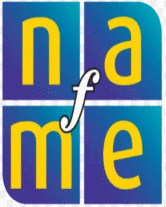Students learn how to solve music and math problems by finding patterns.
Objectives
- Students will identify patterns in notation and number sequences as ways to solve musical and mathematical problems.
Materials
- "Billy Boy," The Music Connection, Grade 3 (Parsippany, NJ: Silver Burdett Ginn, 1995); or World of Music, Grade 3 (Parsippany, NJ: Silver Burdett Ginn, 1991)
- Chalkboard
Prior Knowledge and Experiences
- Students know the pattern sequence of odd and even in the number sequence.
- Students can identify eighth and quarter notes.
Procedure
- Write the pattern "ti-ti tat" on the chalkboard. Ask the students to "pat-pat snap" this pattern several times.
- Ask the students to examine the song "Billy Boy" and count the number of times the "ti-ti ta" pattern is repeated at the beginning of the song (six times). Write the pattern six times in a horizontal sequence. Have the students perform the song by saying "ti-ti ta" and using the "pat-pat snap" movement.
- Ask students to use lower-case letters a for "ti-ti" and b for "ta" to describe this pattern (ab ab ab ab ab ab). Ask students how many items are in each of the six sets on the board (two).
- Ask students to look for other places in the notation where the two eighth notes/quarter note pattern appears. Sing the song while following the notation and looking at the rhythmic patterns. (A small ensemble of rhythm instruments could play an ostinato while others sing.)
- Tell students that mathematics is also filled with interesting patterns, and that they can solve problems with numbers and with musical notation by looking for patterns. Ask students to think of a place in the number line where this same "ab" pattern occurs (odd and even numbers). Ask students to determine whether the math pattern ends after six repetitions. (No, it continues to infinity.)
- Invite students to recite the series of numbers from one to ten. Snap on the odd numbers and pat on the even numbers. Ask how this is similar to the notation pattern at the beginning of "Billy Boy" (both have every other item the same: "ti-ti ta" and "odd/even").
- Ask students to illustrate this pattern sequence using objects, lines, or shapes. Then ask them to create and perform another rhythm that shows the "ab" pattern.
Indicators of Success
- Students locate or create, label, and move to simple "ab" rhythm patterns. Students identify other "ab" patterns in mathematics. For example, when counting by fives, every other number ends in a five.
Extensions
- Have students look at the notation of familiar songs in their student texts. Ask them to find, identify, and perform any repeated rhythm or melody patterns they find (some may be longer than two beats).
- Have students look for and describe repeated patterns in visual art works or posters in the music room or throughout the school.
Standards Correlations
Standard 8
: Understanding relationships between music, the other arts, and disciplines outside the arts: Students identify ways in which the principles and subject matter of other disciplines taught in the school are interrelated with those of music.
Excerpted fromStrategies for Teaching K-4 General Music.

| Provided in partnership with NAfME |
Students learn how to solve music and math problems by finding patterns.
Subjects
TYPE:



